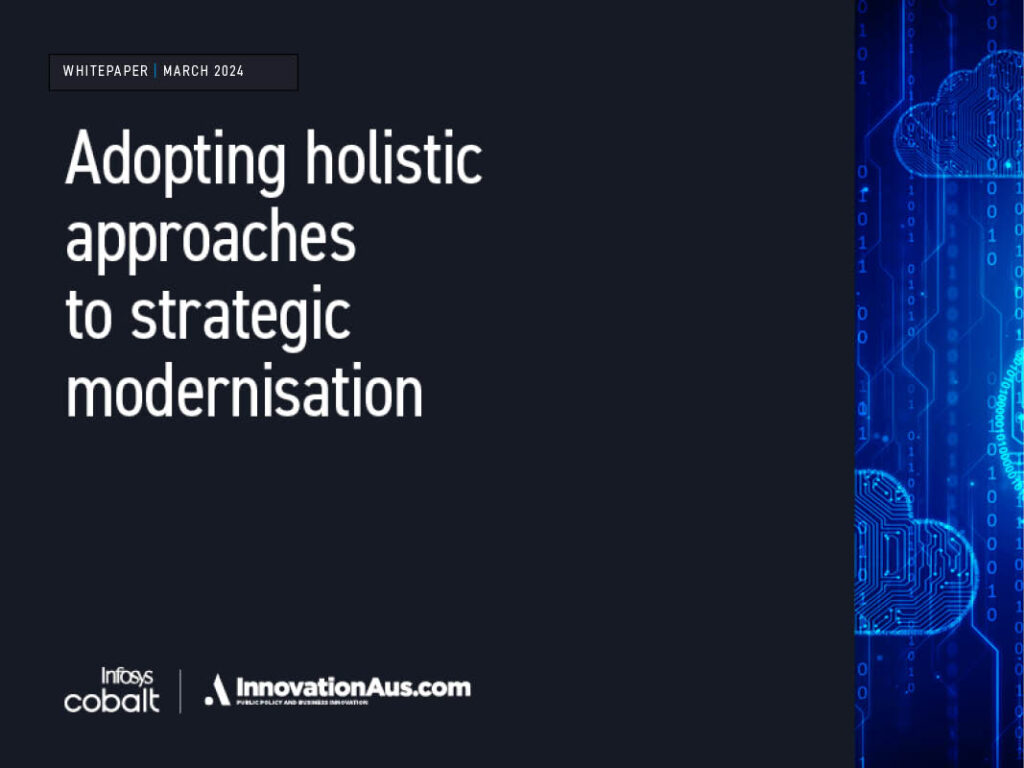The rapidly evolving business landscape, the significant rise in cyber threats and the diminishing pool of legacy system experts are prompting immediate action for strategic modernisation.
Gartner research from 2023 found more than 60 percent of respondents had technical debt as a result of legacy systems, and that this was negatively impacting agility and speed of delivery.
The changing market dynamics and convergence of technology are compelling industry and government leaders to improve and transform their existing systems. This is driven by the need to enhance customer experience, ensure better security, and meet business objectives.
A recent InnovationAus.com whitepaper, Adopting holistic approaches to strategic modernisation, was the result of two roundtable discussions hosted by InnovationAus.com and global digital services and consulting leader, Infosys, where CIOs addressed modernisation issues with their industry peers and discussed how to future-proof systems as part of organisational priorities.
Modernisation paves the way to achieve many organisational goals, including the fulfilment of long-term business objectives, maintaining pace with market changes and allowing for continuous innovation to be future-ready. Therefore, enabling organisations to be resilient, relevant, and responsive must be the central driver when modernising legacy applications with the cloud.

Insights from the roundtable discussions included:
- the need for appropriate drivers for app modernisation
- steering clear of non-modernisation drivers
- the critical factors in modernisation success stories
- reversing failed modernisation programs
- key objectives of the systems integration and development path
- digital technology investments that optimise business and impact
Regarding the need for appropriate app modernisation drivers, it is evident that organisations should adopt technologies that will help them meet their business objectives.
One such objective across the board is the ability to respond quickly to rapidly changing market needs. People on the move and the younger workforce don’t understand the need to put pen to paper; they expect to be able to do everything on their handheld devices.
As crucial as it is to adopt modernisation, it’s equally important to be aware of the challenges that can hinder it, such as navigating cultural change while moving from a legacy environment to a new one. Forward-thinking leadership and the right change management plan are needed to ensure a business’s smooth and strategic modernisation.
Another challenge is the overspend of money and time due to improper planning. It is advisable to calculate the cost-versus-risk factor upfront, which should consider the costs and risks of implementing a modernisation program versus not implementing one.
Not all modernisation programs achieve what the organisation had set out to achieve. To embrace modernisation, existing issues are often overlooked while strategising such programs as they are too entrenched in outdated ways of thinking, resulting in failed modernisation.
In such a scenario, enlisting external guidance can help rewrite the wrongs of failed endeavours and implement a program flexible enough to respond to challenges. However, the holistic question of whether the modernised system complements an organisation’s strategy and objectives must be continually addressed.
“Communication is incredibly important, as is a strategy for how the corporation spends its time, money and resources. Is modernisation going to deliver that, or not? We shouldn’t just assume that it will,” roundtable participant Jim Cooper, chief executive of Terragen Biotech, said.
When it comes to forging systems integration pathways, less is often more. Infosys’ vice president and head of cloud, infrastructure and security services for Asia Pacific and Japan, Vikas Tatwani, cited the case study of a UK bank that offered 400 touchpoints for its customers but deduced that only 20 were relevant or in regular use.
Digital technology that builds business and creates impact centre on “structuring your (investment) thinking can save a lot of pain down the road — and it is quite involved,” according to another participant.
This includes service management from modernisation leaders, extending the notion of digital twins to digital triplicates (as a further safeguard against cyber breaches) and exploring the agility of application tech debt for the long term.
The basis for strategic modernisation is not a one-size-fits-all approach. “The key is to establish a forward-thinking and unified vision for modernisation,” said Naresh Duddu, Infosys’ associate vice president and global head for modernisation.
“This involves following a strategic cost-versus-risk roadmap with measurable metrics, all while being aligned with an organisation’s three crucial pillars: people, process, and technology,” Mr Duddu said.
In the process of looking for a quick fix, enterprises often migrate core systems to the cloud which is not necessarily the complete answer. Some even delay modernisation for decades, causing the legacy systems they seek to upgrade to become obsolete. It is paramount to understand that modernisation is a continuous mechanism of transforming organisational process to improve user experience and not just a technology migration.
Strategic leadership is a critical requirement to build sustainable modernisation at a regulatory and organisational level.
This article was produced by InnovationAus.com in partnership with Infosys. To learn more about Infosys application modernisation services click here.
Do you know more? Contact James Riley via Email.
